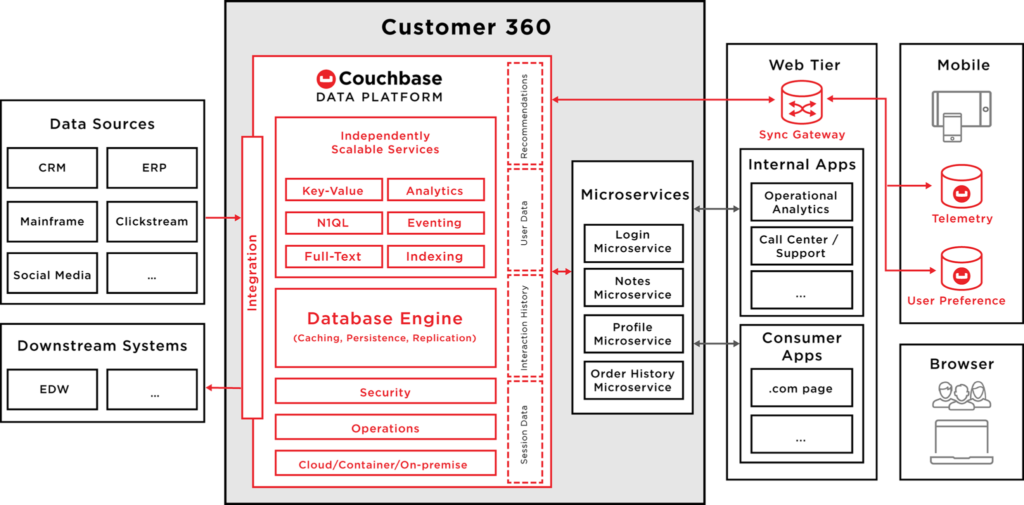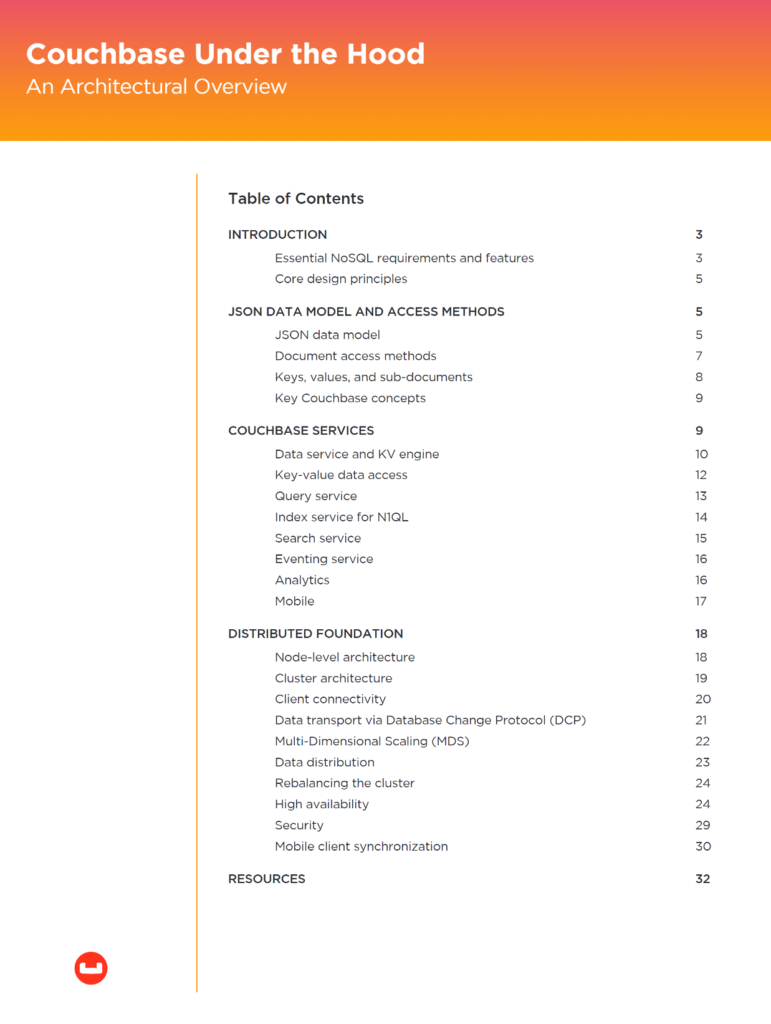Customer obsession is a powerful concept for any company. Whether your customers are internal or external users of your platform – every experience should be timely and meaningful. Customer 360 NoSQL database development is a powerful approach to delivering these experiences.
Today’s technology can both help or hurt customer interaction needs. In this post, we review some of the barriers and show how Couchbase solves them. Take these lessons to help support the next generation of your technical infrastructure.
What is Customer 360?
Customer 360 applications go by many names: single view, golden record, source of truth, and more. All refer to a 360-degree customer view for providing meaningful customer insights.
Having a single consolidated view helps bring together all pieces of information about a customer into a convenient data collection. The data is easily ingested by a system or presented to an end-user application. It should also support the salesforce looking for their next engagement. Requirements vary by the type of application being used, but all have similar backend technical needs.
Having a comprehensive user profile in a mobile application is one such example. If the application can quickly grab a document of all personal information then it can use it immediately. However, if the application has to send a dozen queries to a data warehouse first, then it will suffer.
In another example, e.g., an online shopping website, it is important that the user has access to all the same information mentioned above. But the system should also have access to items such as past purchases, search history, favorite items, and product reviews. This can inform the advertising system and provide offers or suggestions for a personalized experience.
If it takes multiple queries to go and grab this customer profile information, the opportunity to help the customer will be limited.
Architecting a Customer 360 NoSQL Database Solution
Application developers, architects, and data managers have the challenging task of drawing customer data from many data sources and systems. Their goal must be to service their internal users with timely data and their external customers with instant information.
Developers may struggle to meet the demand of their customers because of poorly architected platforms underlying their solutions. They need a way to converge the tech and align their solutions efficiently.
There are a set of common pain points when developing and supporting these applications while bringing them into the modern era. Three popular challenges are described here, with suggestions for how to work around and solve them.
Unified Data / Golden Record
Anytime that the term converge is used, it implies an exercise in bringing data together from multiple sources. This is precisely the case with a customer 360 single view application – data about the customer must be compiled and made accessible to customers or customer service representatives.
The challenge lies with dissociated big data systems that do not work together to proactively support a unified customer picture. The nature of the enterprise itself may influence this, as different types of data are from different omnichannel application, financial, and user profile sources. The more systems that are in play, the more challenging the convergence exercise.
Creating a single source of truth about the customer requires data management systems that serve as platforms to hold, process, and manage the single view of the customer information. For example, a single JSON document or a data collection stored in a key-value database in some other format works well.
The data could also be readily available through a typical database query if possible but it must be easy to implement so that developers can focus on the overall solution instead.
Solved: Unified Developer Platform
The solution to the first part of these challenges is getting the data together. A good ETL system can help do it on a periodic basis, but ideally, a real-time streaming solution such as Kafka would help keep everything connected and up to date without the need for user intervention.
This graphic shows how a larger, more complex, enterprise might integrate Couchbase as the core layer between data sources and outward-facing applications.

Second, the output of such a streaming system should be to a developer-friendly platform, ideally a document database that can handle data in a flexible way. Couchbase NoSQL database was specifically created to serve as such a platform.
Once data is ingested, it can be fetched by a simple key name, queried with SQL query language statements, or search using natural language (full-text search). The single SDK for developers makes it easy, and the automated support for these different endpoints makes it easy to maintain.
Keeping Up With Customer Data
The second challenge we find in customer 360 solutions is data availability and data volume challenges. Customer data can become out-of-date or stale due to the limitations of underlying systems. Keeping data current can be hard if you are always running out of space, or only storing limited past information.
If the collection of data takes too long to prepare, it becomes the bottleneck. Applications struggle to get real-time data access if the process behind-the-scenes is onerous or inefficient. Customer 360 NoSQL database solutions must be able to deliver that real-time experience during development but also during production.
Solved: Real-time Availability & Scalability
Everyone wants all the data, all the time, and right away. This is not always a daydream if the platform is architected to support both vertical or horizontal scaling and data consistency.
Real-time applications are limited by real-time access to data. Any database has to be fast and efficient. Successful platforms will focus on having streamlined plumbing, like Couchbase does, between nodes in a cluster.
When more processing power is needed, more nodes are added, but the overhead of keeping things up-to-date shouldn’t grow out of control. When more data storage is needed, the system should adjust to the business and carry on as your customer base grows.
Slowly going away are the days of massive capital expenditures to have more than enough volume “just in case”. Many data platforms become a challenge to manage as they grow, but Couchbase automates the management of clusters with one node or one hundred nodes.
Overly Complex Infrastructure
As enterprises grow larger and more complex, their infrastructure often mirrors it. Every department has its particular data and analytical needs, each with its own software solutions. Different products are needed for different goals: operations, planning, analytics, financial.
Different types of end-user applications have their own data needs as well, including internal corporate systems, support for edge computing and mobile apps, online shopping portals, and more.
The result is having a collection of relational databases, NoSQL systems, graph databases, key-value stores, and all sorts of both proprietary and open source solutions, etc.
In the end, different workgroups have different needs and this makes administration complex. Multiple software vendors increase costs and training needs, affecting corporate profitability.
Read about how Couchbase helped Facet Digital by reducing their time-to-market, costs, and latency for their customer-focused application.
Solved: Simplified Multi-model NoSQL Architecture
Different technologies are used to serve different end-user applications but it is possible to use a singular core technology that services multiple end goals instead. For example, Couchbase can ingest generic data, JSON documents, tables, etc., and make them available to different kinds of developers.
No additional tooling required – a developer can send a query or a text search to one system and get timely responses.
Couchbase 360 NoSQL database developers start by using Couchbase as a high performance caching solution. After they see how stable and effective the platform is, they then look to converging other systems to use Couchbase directly.
Using common data connectors and streaming systems, Couchbase can replace relational databases, full-text search systems, or even object-oriented databases, depending on need.
Because these are different features built into a single platform, there is only one platform to support and one developer SDK to use. This helps to streamline cost, maintenance, and support over the long term.
Collapsing multiple complex solutions into a powerful, scalable, single-source solution is needed now more than ever to keep costs low and success high.
Getting Started with Couchbase NoSQL
- Start with a trial of Couchbase Cloud – no installation required. Start building more powerful applications more quickly than ever before.
- Dive deeper by reading the Couchbase Under the Hood – Architectural Overview and see how the magic is made!
- Explore the different services that Couchbase delivers: mobile support, SQL querying, full-text search, eventing, and big data analytics,

